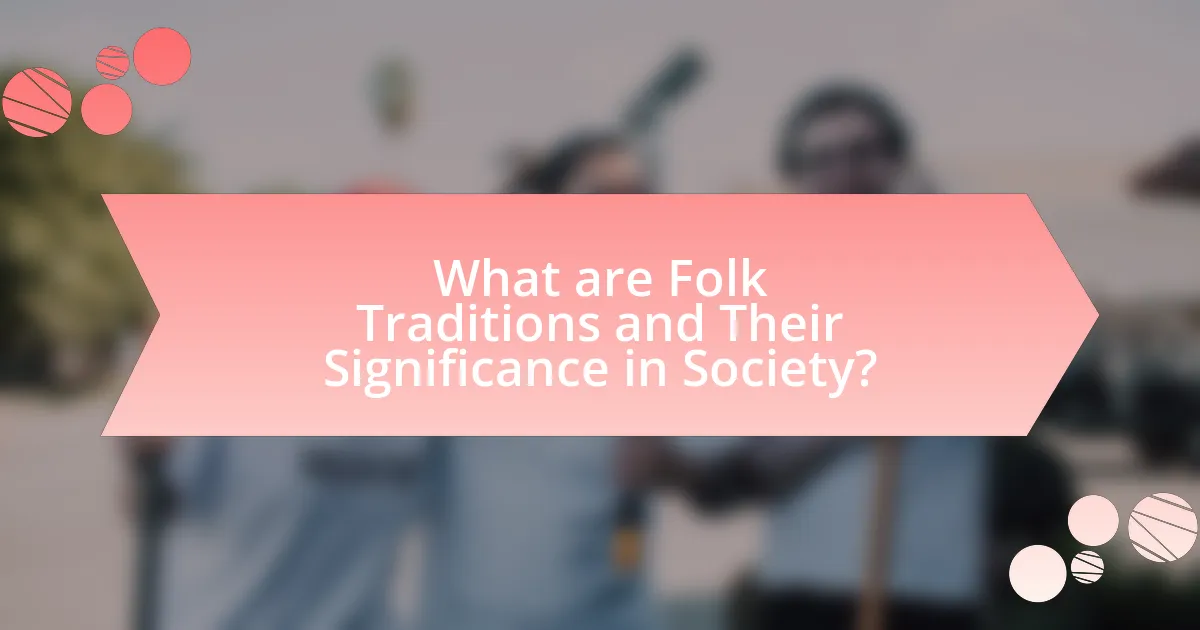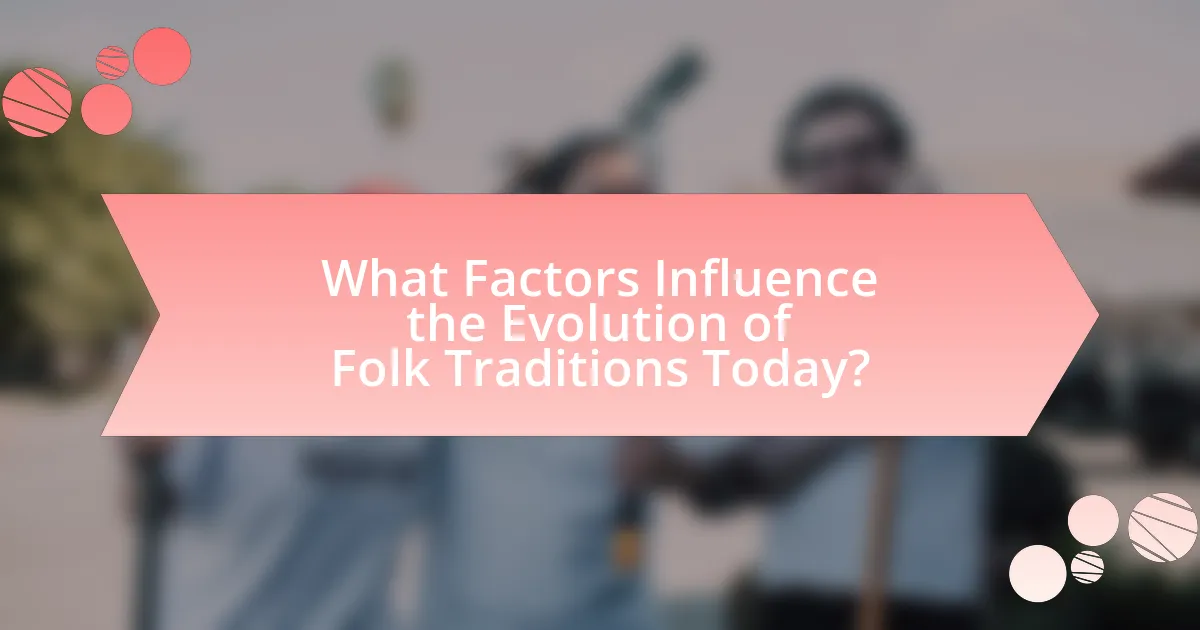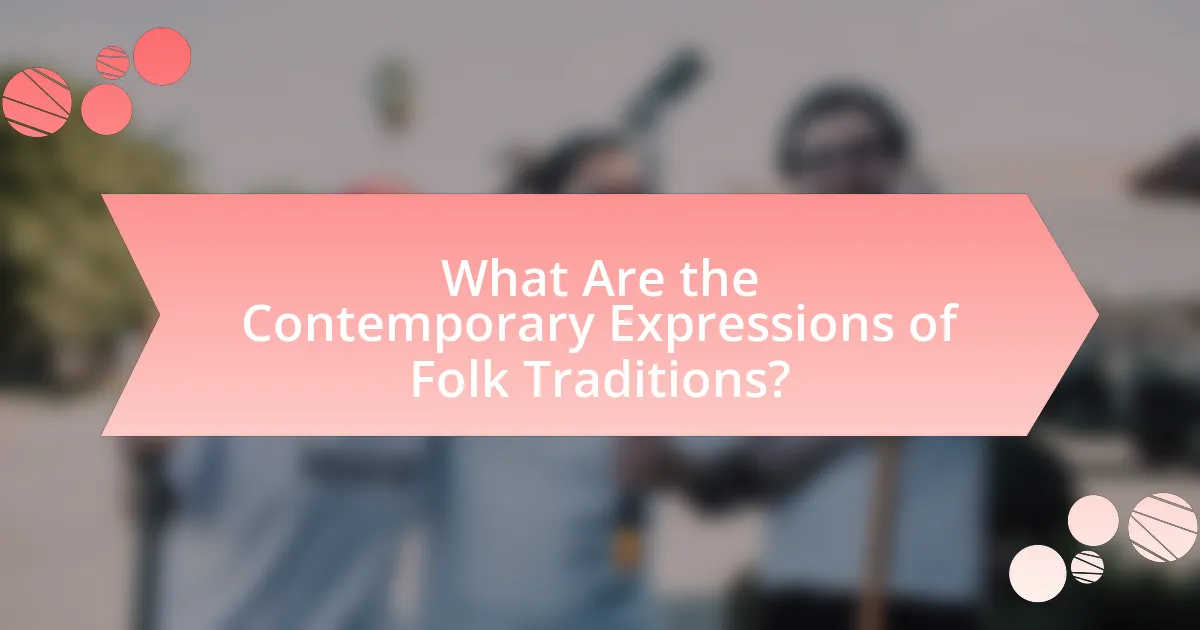Folk traditions encompass cultural practices, beliefs, and customs that are transmitted through generations within communities, playing a vital role in preserving cultural heritage and fostering social cohesion. This article examines the evolution of folk traditions in modern society, highlighting their significance in maintaining cultural identity amidst globalization and technological advancements. It explores how historical events, cultural exchanges, and contemporary expressions influence these traditions, as well as the challenges they face today. Additionally, the article discusses best practices for preserving folk traditions and engaging younger generations, emphasizing the importance of documentation, community involvement, and education in sustaining these cultural practices.

What are Folk Traditions and Their Significance in Society?
Folk traditions are cultural practices, beliefs, and customs passed down through generations within a community, often reflecting the identity and values of that group. Their significance in society lies in their role in preserving cultural heritage, fostering community cohesion, and providing a sense of belonging. For instance, folk traditions such as storytelling, music, and dance serve as vehicles for transmitting historical narratives and moral lessons, thereby reinforcing social norms and collective memory. Additionally, studies have shown that communities engaged in folk traditions experience stronger social ties and enhanced cultural identity, which are crucial for resilience in the face of modernization and globalization.
How have folk traditions evolved over time?
Folk traditions have evolved over time through processes of adaptation, cultural exchange, and modernization. Initially rooted in oral storytelling, rituals, and communal practices, these traditions have transformed as societies have changed, influenced by factors such as migration, globalization, and technological advancements. For example, the introduction of digital media has allowed folk music and storytelling to reach wider audiences, leading to hybrid forms that blend traditional elements with contemporary styles. Additionally, the revival movements in the 20th century, such as the folk revival in the United States during the 1960s, showcased a renewed interest in preserving and reinterpreting folk traditions, demonstrating their dynamic nature.
What historical events have influenced the evolution of folk traditions?
Historical events such as the Industrial Revolution, colonization, and major wars have significantly influenced the evolution of folk traditions. The Industrial Revolution, which began in the late 18th century, led to urbanization and the decline of agrarian lifestyles, causing many folk traditions to adapt or fade as communities transformed. Colonization often resulted in the blending or suppression of indigenous folk traditions, as seen in the Americas and Australia, where European settlers imposed their cultural practices. Additionally, major wars, such as World War I and World War II, disrupted communities and altered social structures, leading to the revival or reinterpretation of folk traditions as a means of cultural identity and resilience. These events collectively shaped the way folk traditions are practiced and perceived in modern society.
How do cultural exchanges impact folk traditions?
Cultural exchanges significantly influence folk traditions by introducing new elements and practices that can be integrated into existing cultural frameworks. These exchanges often lead to the adaptation and evolution of traditional customs, as seen in the blending of music, dance, and culinary practices from different cultures. For instance, the incorporation of African rhythms into American folk music has created genres like jazz and blues, demonstrating how cultural interactions can reshape artistic expressions. Additionally, research indicates that cultural exchanges can enhance community engagement and promote cultural preservation, as communities adapt to incorporate diverse influences while maintaining their unique identities. This dynamic interplay between cultures fosters innovation and revitalization within folk traditions, ensuring their relevance in a globalized society.
Why are folk traditions important in modern society?
Folk traditions are important in modern society because they preserve cultural identity and foster community cohesion. These traditions serve as a means of transmitting values, beliefs, and historical narratives across generations, which is crucial for maintaining a sense of belonging and continuity in an increasingly globalized world. For instance, UNESCO recognizes the significance of intangible cultural heritage, highlighting that folk traditions contribute to social stability and cultural diversity. By participating in folk traditions, individuals strengthen their connections to their heritage and to one another, reinforcing social bonds and promoting mutual understanding.
What role do folk traditions play in cultural identity?
Folk traditions play a crucial role in shaping cultural identity by preserving and transmitting the values, beliefs, and practices of a community. These traditions serve as a means of connecting individuals to their heritage, fostering a sense of belonging and continuity across generations. For instance, rituals, storytelling, and traditional crafts not only reflect the historical experiences of a group but also reinforce social cohesion and collective memory. Research indicates that communities that actively engage in folk traditions exhibit stronger cultural identity and resilience against globalization, as these practices provide a unique sense of place and identity that distinguishes them from others.
How do folk traditions contribute to community cohesion?
Folk traditions contribute to community cohesion by fostering shared identity and collective values among community members. These traditions, such as festivals, storytelling, and rituals, create opportunities for social interaction and bonding, reinforcing a sense of belonging. For instance, research indicates that communities that actively engage in folk traditions experience lower levels of social isolation and increased trust among residents, as seen in studies conducted by the University of California, which found that participation in local cultural events significantly enhances community ties.

What Factors Influence the Evolution of Folk Traditions Today?
The evolution of folk traditions today is influenced by globalization, technological advancements, and cultural exchange. Globalization facilitates the blending of diverse cultural practices, allowing folk traditions to adapt and incorporate elements from various cultures. Technological advancements, such as social media and digital platforms, enable the rapid dissemination and transformation of folk traditions, making them accessible to a wider audience. Cultural exchange through migration and travel introduces new ideas and practices, further shaping the evolution of these traditions. For example, the rise of online platforms has led to the revival and reinterpretation of traditional music and dance forms, demonstrating how contemporary influences can reshape folk traditions while preserving their core elements.
How does globalization affect folk traditions?
Globalization significantly impacts folk traditions by facilitating cultural exchange and leading to the dilution or transformation of local customs. As global communication and travel increase, traditional practices often blend with external influences, resulting in hybrid forms of expression. For instance, the UNESCO report on cultural diversity highlights that many folk traditions are at risk of being overshadowed by dominant global cultures, which can lead to a loss of authenticity and uniqueness. Additionally, the proliferation of digital media allows for wider dissemination of folk traditions, but it can also commercialize and commodify them, altering their original meanings and contexts.
What are the positive impacts of globalization on folk traditions?
Globalization positively impacts folk traditions by facilitating cultural exchange and increasing visibility. This exchange allows folk traditions to be shared and appreciated across diverse cultures, leading to a revival and adaptation of these traditions. For instance, the global popularity of world music has led to the incorporation of traditional instruments and styles into contemporary genres, enhancing their relevance. Additionally, globalization promotes tourism, which often highlights local customs and practices, providing economic benefits and encouraging communities to preserve their heritage. Studies show that regions embracing globalization often see a resurgence in traditional arts and crafts, as they gain access to broader markets and audiences.
What challenges do folk traditions face due to globalization?
Folk traditions face significant challenges due to globalization, primarily through cultural homogenization and the erosion of local identities. Globalization promotes the widespread dissemination of dominant cultures, often leading to the marginalization of unique folk practices. For instance, the proliferation of global media and consumer culture can overshadow traditional customs, making them less relevant to younger generations. Additionally, economic pressures may compel communities to prioritize tourism and commercialization over authentic cultural expressions, further diluting the essence of folk traditions. Research indicates that as global interconnectedness increases, local traditions struggle to maintain their distinctiveness, resulting in a loss of cultural diversity.
How do technological advancements shape folk traditions?
Technological advancements shape folk traditions by facilitating the dissemination and transformation of cultural practices. For instance, the rise of social media platforms allows for the rapid sharing of folk stories, music, and art, leading to a wider audience and the blending of traditional elements with contemporary influences. Research indicates that digital tools enable communities to document and preserve their heritage, as seen in projects like the Smithsonian Folkways Recordings, which utilize technology to archive and promote traditional music. This integration of technology not only revitalizes interest in folk traditions but also encourages innovation within those traditions, as artists and communities adapt to new mediums and audiences.
In what ways has social media transformed the sharing of folk traditions?
Social media has transformed the sharing of folk traditions by enabling rapid dissemination, fostering global connections, and facilitating interactive engagement. Platforms like Facebook, Instagram, and TikTok allow users to share videos, images, and stories related to their cultural practices, reaching wider audiences than traditional methods. For instance, viral challenges or hashtags can promote specific folk traditions, as seen with the #FolkloreChallenge on TikTok, which encourages users to share their cultural heritage. Additionally, social media creates communities where individuals can exchange knowledge and experiences, preserving and revitalizing folk traditions in a modern context. This shift has led to a resurgence of interest in local customs, as evidenced by increased participation in cultural events and festivals promoted online.
How do digital platforms help preserve folk traditions?
Digital platforms help preserve folk traditions by providing accessible spaces for sharing and documenting cultural practices. These platforms enable communities to upload videos, audio recordings, and written accounts of their traditions, ensuring that they are not lost to time. For instance, social media sites allow users to showcase traditional music, dance, and storytelling, reaching wider audiences and fostering intergenerational connections. Research indicates that online archives and digital storytelling initiatives have successfully recorded and disseminated folk traditions, as seen in projects like the Smithsonian Folkways Recordings, which has preserved thousands of cultural expressions from around the world.

What Are the Contemporary Expressions of Folk Traditions?
Contemporary expressions of folk traditions include music, dance, storytelling, crafts, and culinary practices that reflect cultural heritage while adapting to modern contexts. These expressions often manifest in festivals, community events, and digital platforms, showcasing traditional elements alongside contemporary influences. For instance, folk music genres have evolved through fusion with popular music styles, and traditional crafts are marketed through online platforms, reaching wider audiences. The National Endowment for the Arts reports that folk arts contribute significantly to cultural identity and community cohesion, illustrating their ongoing relevance in today’s society.
How are folk traditions represented in modern art and music?
Folk traditions are represented in modern art and music through the incorporation of traditional themes, motifs, and techniques that reflect cultural heritage. Artists and musicians often draw inspiration from folk narratives, instruments, and styles, blending them with contemporary forms to create a dialogue between the past and present. For instance, the use of traditional instruments like the banjo in American folk music or the incorporation of indigenous patterns in visual art exemplifies this fusion. Additionally, modern artists such as Ai Weiwei and musicians like Mumford & Sons have successfully integrated folk elements into their work, highlighting the relevance of these traditions in today’s cultural landscape. This representation not only preserves folk traditions but also revitalizes them, making them accessible to new audiences.
What are some examples of folk-inspired contemporary art?
Folk-inspired contemporary art includes works that draw from traditional folk themes, techniques, and narratives. Examples of this genre are the textile art of El Anatsui, which incorporates traditional African weaving methods and materials, and the paintings of Kehinde Wiley, who often reinterprets classical portraiture through the lens of contemporary urban culture. Additionally, the work of artists like Faith Ringgold, known for her narrative quilts that reflect African American history and folklore, exemplifies the integration of folk elements into modern artistic practices. These artists demonstrate how folk traditions can be reimagined and celebrated in contemporary contexts, bridging cultural heritage with modern expression.
How do modern musicians incorporate folk traditions into their work?
Modern musicians incorporate folk traditions into their work by blending traditional melodies, instruments, and storytelling techniques with contemporary genres. This fusion often results in a unique sound that resonates with both historical roots and modern sensibilities. For example, artists like Mumford & Sons utilize traditional folk instruments such as the banjo and mandolin while infusing their music with modern rock elements, creating a crossover appeal. Additionally, musicians like Rhiannon Giddens draw directly from African American folk traditions, using historical narratives and traditional songs to address contemporary social issues, thereby preserving and revitalizing these cultural expressions. This integration not only honors the past but also ensures that folk traditions remain relevant in today’s musical landscape.
What role do festivals play in the preservation of folk traditions?
Festivals play a crucial role in the preservation of folk traditions by providing a platform for communities to celebrate and showcase their cultural heritage. These events facilitate the transmission of traditional practices, stories, and art forms across generations, ensuring that they remain relevant and vibrant. For instance, festivals often include performances of traditional music and dance, which not only entertain but also educate attendees about their cultural roots. Research indicates that participation in cultural festivals can enhance community identity and cohesion, reinforcing the importance of folk traditions in contemporary society.
How do festivals promote awareness of folk traditions?
Festivals promote awareness of folk traditions by serving as platforms for cultural expression and community engagement. These events showcase traditional music, dance, crafts, and culinary practices, allowing participants and attendees to experience and learn about their heritage. For instance, the annual Smithsonian Folklife Festival in Washington, D.C., highlights diverse cultural practices, drawing attention to the importance of preserving these traditions. Additionally, festivals often include workshops and demonstrations, which educate the public about the historical significance and techniques behind folk arts, thereby reinforcing cultural identity and continuity.
What are some notable folk festivals around the world?
Notable folk festivals around the world include the Albuquerque International Balloon Fiesta in the United States, which attracts over 800 hot air balloons and 100,000 visitors annually, showcasing the cultural significance of ballooning. Another prominent festival is the Edinburgh Festival Fringe in Scotland, recognized as the world’s largest arts festival, featuring thousands of performances across various genres, including folk music and dance. The Harbin International Ice and Snow Sculpture Festival in China celebrates winter traditions with massive ice sculptures and attracts millions of visitors, highlighting the cultural importance of winter festivities. Additionally, the Festival of the Sun in Peru honors the Incan sun god Inti, featuring traditional music, dance, and rituals, reflecting the deep-rooted folk traditions of the Andean culture. These festivals exemplify the rich diversity and cultural heritage found in folk traditions globally.
What are some best practices for preserving folk traditions in modern society?
Best practices for preserving folk traditions in modern society include documentation, community engagement, and education. Documentation involves recording oral histories, songs, and practices to ensure they are not lost; for example, the Smithsonian Institution has extensive archives that preserve various cultural traditions. Community engagement encourages participation in traditional events and rituals, fostering a sense of belonging and continuity; studies show that communities actively involved in their cultural heritage are more likely to sustain those traditions. Education, particularly through schools and workshops, helps younger generations understand and appreciate their cultural heritage, as evidenced by programs like the National Endowment for the Arts, which supports folk arts education initiatives.
How can communities engage younger generations in folk traditions?
Communities can engage younger generations in folk traditions by incorporating technology and interactive experiences into traditional practices. For instance, using social media platforms to share folk stories, music, and dance can attract younger audiences who are already active online. Additionally, organizing workshops that blend traditional skills with modern creativity, such as crafting or cooking classes, can make folk traditions more appealing. Research indicates that hands-on participation increases interest; a study by the National Endowment for the Arts found that interactive cultural experiences significantly enhance engagement among youth. By making folk traditions accessible and relevant, communities can foster a deeper appreciation and connection to their cultural heritage.
What resources are available for those interested in learning about folk traditions?
Books, academic journals, online courses, and cultural organizations are key resources for learning about folk traditions. Notable books include “The Study of Folk Culture” by Richard Dorson, which provides foundational knowledge, and “Folk Traditions in the Modern World” by Anne K. Smith, which explores contemporary practices. Academic journals such as “Folklore” and “Western Folklore” publish peer-reviewed articles on various aspects of folk traditions. Online platforms like Coursera and edX offer courses on cultural studies that include folk traditions. Additionally, organizations like the American Folklife Center and the International Society for Folk Narrative Research provide access to archives, workshops, and community events that promote the understanding of folk traditions.
